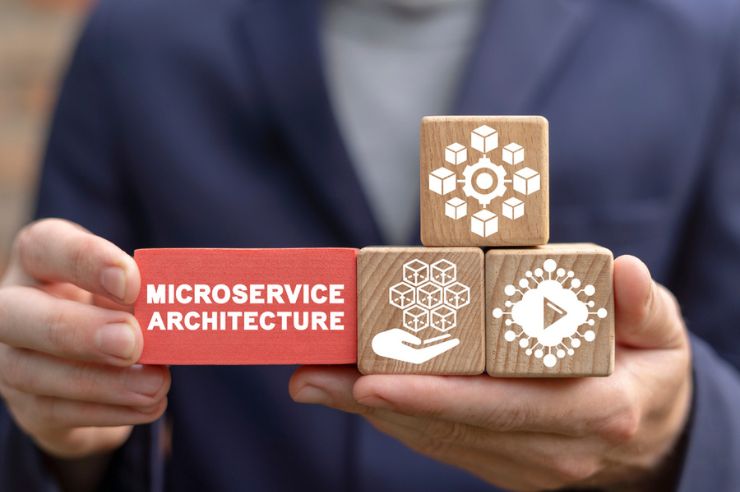The architecture behind eCommerce platforms is a critical factor that dictates their efficiency, scalability, and ability to adapt to changing consumer demands. We’ll delve into the transformative power of eCommerce microservices, discuss the advantages of adopting microservices, and compare microservices architecture to monolith architecture.
What Are eCommerce Microservices?

eCommerce microservices represent a significant shift from traditional monolithic architectures, breaking down complex eCommerce platforms into smaller, independent services. Each microservice is designed to perform a specific business function—such as inventory management, payment processing, or customer support—and operates autonomously yet interacts seamlessly with other services through well-defined APIs. This architectural approach enables enhanced scalability, as services can be scaled independently to meet demand without affecting the entire system. It also improves resilience since the failure of one service does not impact the overall platform and increases development agility, allowing for faster updates and feature deployment.
The move towards microservices is supported by advancements in containerization and orchestration technologies, like Docker and Kubernetes. These technologies facilitate the consistent deployment and management of these services across various environments, which aids in maintaining operational flexibility and ensures that businesses can rapidly adapt to market changes and integrate new technologies without the need for comprehensive system overhauls.
The Advantages of Adopting Microservices
Adopting microservices architecture in the eCommerce domain offers many advantages directly contributing to digital retail platforms’ agility, scalability, and resilience. Below, we delve into the specific advantages of e-commerce microservices.
Enhanced Scalability
Targeted Scaling
Microservices can be scaled independently, allowing for precise resource allocation where it’s needed most, without the need to scale the entire application. For instance, during a flash sale, the order processing microservice can be scaled up to handle the increased load while other services remain unaffected.
Cloud-Readiness
Microservices are inherently designed for cloud environments, benefiting from cloud providers’ auto-scaling capabilities and pay-as-you-go pricing models, which can significantly reduce operational costs.
Improved Resilience
Isolated Failures
In a microservices architecture, the failure of one service does not necessarily lead to system-wide downtime. This isolation can enhance the overall uptime of an eCommerce platform.
Rapid Recovery
The modular nature of microservices allows for quicker identification and resolution of issues, minimizing the impact on customer experience.
Faster Time-to-Market
Parallel Development
Development teams can work on different microservices simultaneously, reducing dependencies and accelerating the development cycle.
Continuous Deployment
Microservices facilitate continuous integration and continuous deployment (CI/CD) practices, allowing for frequent and incremental updates without disrupting the service.
Flexibility in Technology Stack
Technology Diversity
Each microservice can be built using the most appropriate technology stack for its specific functionality, allowing teams to leverage the best tools available for each task.
Experimentation and Innovation
The decoupled nature of microservices makes it easier to experiment with new technologies and approaches in a controlled manner, fostering innovation.
Enhanced Customer Experience
Personalization at Scale
Microservices enable the implementation of advanced algorithms for personalization, allowing eCommerce platforms to offer tailored shopping experiences to millions of users simultaneously.
Dynamic Content Delivery
Content and product recommendations can be dynamically adjusted in real-time, enhancing user engagement and satisfaction.
Operational Efficiency
Resource Optimization
Microservices use resources more efficiently than monolithic architectures, as each service can be deployed on the most suitable infrastructure, reducing wastage.
Automated Management
Orchestration tools like Kubernetes automate the deployment, scaling, and management of microservices, further reducing operational overhead.
Improved Security
Fine-Grained Access Control
Microservices can implement their own security policies, including authentication and authorization, limiting the scope of potential security breaches.
Rapid Patching
Security patches and updates can be applied to individual microservices without the need to take down the entire system, ensuring continuous protection against vulnerabilities.
Cost Savings
Reduced Infrastructure Costs
Businesses can achieve significant cost savings on infrastructure by optimizing resource usage and leveraging cloud scalability.
Lower Development Costs
The ability to develop and deploy services independently reduces the complexity and cost of software development, testing, and maintenance.
Data Management and Analytics
Dedicated Data Stores
Microservices can have dedicated databases, optimizing data management and query performance for each service’s specific needs.
Real-Time Analytics
The modular nature of microservices facilitates the implementation of real-time analytics and monitoring, enabling businesses to respond swiftly to market trends and customer behaviors.
eCommerce businesses can harness these advantages to build more robust, scalable, and customer-centric digital platforms by transitioning to a microservices architecture. This strategic move positions companies for current success and lays a foundation for future growth and innovation in the competitive eCommerce landscape.
Examples of eCommerce Microservices

Several leading eCommerce companies have pioneered the use of microservices, transforming their digital platforms to offer better scalability, flexibility, and customer experience. Here are some real-life examples of specific microservices employed by renowned eCommerce businesses:
Amazon
Order Management Microservice
Amazon’s order management system is a prime example of microservice architecture in action. This service autonomously handles order processing, tracking, and fulfillment, enabling Amazon to efficiently manage millions of orders across the globe with varying delivery requirements.
Recommendation Engine
Amazon’s recommendation engine is another notable microservice, using sophisticated algorithms to analyze customer behavior, browsing history, and purchase patterns to suggest personalized product recommendations.
Netflix
Content Delivery Microservice
Netflix employs a content delivery network (CDN) microservice that optimizes the streaming experience for users worldwide. This service dynamically adjusts video quality based on the user’s internet speed and device, ensuring a seamless viewing experience.
User Authentication Service
This critical microservice manages user logins and session data across devices, supporting Netflix’s multi-device streaming capability. It ensures secure access and maintains user session continuity.
eBay
Search and Catalog Microservice
eBay’s search functionality is powered by a dedicated microservice that handles queries across an extensive catalog of listings. It provides fast, relevant search results by indexing products and utilizing advanced search algorithms.
Payment Processing Microservice
eBay processes payments through a microservice that integrates various payment methods, ensuring secure and efficient transactions. This service is crucial for facilitating the diverse payment preferences of eBay’s global user base.
Zalando
Fashion Recommendation Microservice
Zalando uses a fashion recommendation microservice that suggests products based on user preferences, browsing behavior, and purchase history. This service enhances the shopping experience by personalizing product offerings.
Order and Inventory Management Microservice
This microservice ensures that Zalando’s inventory is accurately reflected in real-time, managing stock levels and order fulfillment processes to optimize supply chain efficiency.
Alibaba
Payment and Financial Services Microservice
Alipay, part of Alibaba Group, operates its payment services as a microservice, offering a secure and convenient payment gateway for Alibaba’s eCommerce platforms and beyond.
Logistics and Tracking Microservice
Alibaba’s Cainiao Network utilizes microservices to manage logistics and provide real-time tracking information, optimizing delivery routes and improving the efficiency of cross-border shipments.
These examples underscore the transformative impact of microservices in eCommerce. By adopting microservices, these companies have set new standards for operational excellence in the digital marketplace, enabling industry leaders to scale operations, enhance user experiences, and maintain high levels of service reliability.
Microservices Architecture vs Monolith Architecture

The debate between microservices and monolithic architectures is a common one. Understanding the nuances, benefits, and challenges of each approach is crucial for businesses aiming to leverage technology for competitive advantage. Here, we break down microservices architecture vs monolith architecture.
Microservices Architecture
Definition: Microservices architecture consists of small, autonomous services that work together. Each service is self-contained and implements a single business capability.
Scalability: Microservices excel in scalability. They can be scaled independently, allowing for more precise resource allocation based on demand. This trait is particularly beneficial during high-traffic periods in eCommerce operations.
Development and Deployment: Offers agility in development and deployment. Teams can work on different services simultaneously, reducing the time to market for new features. Continuous integration and deployment (CI/CD) are more seamlessly integrated into microservices architectures.
Technology Diversity: Each microservice can utilize the most suitable technology stack for its specific function, encouraging innovation and the use of the best tools for each task.
Resilience: The failure of one microservice does not necessarily compromise the entire system, enhancing overall reliability and uptime for eCommerce platforms.
Challenges: Complexity in managing multiple services, data consistency across services, and the initial overhead of setting up a microservices infrastructure.
Monolithic Architecture
Definition: Monolithic architecture is a traditional unified software design model in which all eCommerce platform components are tightly integrated into a single, indivisible unit.
Scalability: Scaling a monolithic application means scaling the entire application, even if only one feature is experiencing high demand, which can lead to inefficient resource use and increased costs.
Development and Deployment: Changes or updates require redeploying the entire application, which can slow down the development process and challenge continuous delivery.
Technology Stack: Monolithic applications are generally limited to a single technology stack, which can restrict the use of new technologies and slow innovation.
Resilience: A bug in any module can potentially bring down the entire system, posing a significant risk to business continuity and customer experience.
Challenges: Over time, the codebase can become unwieldy, making it difficult to maintain and update. This “code spaghetti” can slow development velocity and complicate the onboarding of new developers.
Comparative Analysis
| Factor | Microservices Architecture | Monolithic Architecture |
| Initial Setup and Complexity | Requires significant upfront investment in defining service boundaries, setting up CI/CD pipelines, and ensuring inter-service communication. | Simpler initial setup with a single codebase and development environment, making it easier to start and deploy initially. |
| Technology Stack Flexibility | High flexibility allows each service to choose the best technology for its needs, promoting innovation. | Limited to a single technology stack for the entire application, which may hinder the adoption of new technologies. |
| Scalability and Performance | Services can be scaled independently based on demand, optimizing resource utilization and performance. | Scaling requires scaling the entire application, which can be resource-intensive and inefficient for specific functionalities. |
| Deployment Speed | Faster and more frequent deployments are possible for individual services, reducing downtime and risk. | Deployments involve the entire application, which can be slower and riskier, especially for large applications. |
| Resilience and Isolation | Failure in one service does not impact the entire system, enhancing overall resilience. | A bug or failure in any part of the application can potentially bring down the whole system. |
| Maintenance and Updates | Easier to maintain and update individual services, allowing for continuous improvement and adaptation. | Over time, the codebase can become complex and difficult to manage, slowing down updates and maintenance. |
| Cross-functional Teams | Encourages small, autonomous teams responsible for specific services, promoting agility and ownership. | Often relies on larger, centralized teams, which can slow decision-making and innovation due to dependencies. |
| Cost Implications | Initial higher costs due to the complexity of managing multiple services can lead to cost savings through efficient scaling and reduced downtime. | Lower initial costs but the potential for higher operational costs in the long run due to scalability and maintenance challenges. |
Flexibility and Innovation: Microservices offer superior flexibility and enable innovation by allowing the use of different technologies and making it easier to experiment with new features.
Risk and Resilience: Microservices are more resilient against system-wide failures, whereas monolithic architectures present a single point of failure.
Complexity and Overhead: While microservices introduce complexity in managing distributed systems, monolithic architectures can become cumbersome and resistant to changes as they grow.
Scalability and Efficiency: Microservices allow targeted scaling, optimizing resource use and cost. Monolithic systems may require scaling the entire application for a single feature’s demand.
Development Speed: Initially, monolithic architectures may speed up development and deployment. However, as applications grow, microservices facilitate faster development cycles and easier deployment of new features.
The eCommerce business’s specific needs, scale, and long-term vision should inform the choice between microservices and monolithic architecture. Microservices architecture offers a path to greater agility, resilience, and scalability. However, careful consideration of the associated complexity and initial investment in infrastructure and expertise is required. Monolithic architectures, while potentially simpler to develop and deploy initially, may not offer the same level of flexibility or scalability as businesses grow and evolve.
Work With The Professionals
From the agility and resilience they offer to the scalability and innovation they foster, eCommerce microservices are not just transforming eCommerce platforms—they’re redefining the future of online retail.
However, the journey towards microservices architecture is not without its challenges. It requires a thoughtful consideration of the initial setup complexities, the management of distributed systems, and the strategic investment in the necessary infrastructure and expertise. The decision between microservices and monolithic architectures should be informed by your business’s specific needs, its scale, and its long-term vision for growth and innovation.
If your eCommerce business is poised to adopt these new changes, seeking the right partner to guide you through the complexities of microservices architecture is crucial. Oyova stands ready to be that partner. With our expertise in Shopify development services, we can help you unlock the full potential of your eCommerce venture, ensuring it’s positioned for current success and future growth. Reach out to us today to get started.
